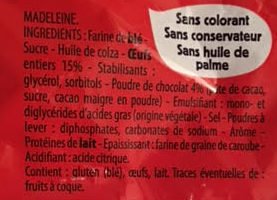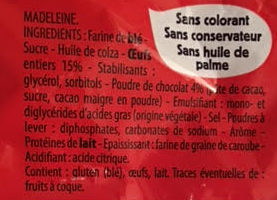Ker Cadélac - Madeleines Marble Chocolate, 600g (21.2oz) - 600 g e (24 * 25 g)
This product page is not complete. You can help to complete it by editing it and adding more data from the photos we have, or by taking more photos using the app for Android or iPhone/iPad. Thank you!
×
Barcode: 3259426031441 (EAN / EAN-13)
Common name: Madeleines au chocolat - Madeleines Extra Moelleuses Marbrées Chocolat
Quantity: 600 g e (24 * 25 g)
Brands: Ker Cadélac
Categories: Snacks, Desserts, Sweet snacks, Biscuits and cakes, Cakes, Chocolate cakes, Madeleines, Chocolate madeleines
Labels, certifications, awards:
No preservatives, Green Dot, No colorings, No palm oil, Produced in Brittany
Manufacturing or processing places: Bretagne, France
Link to the product page on the official site of the producer: https://www.kercadelac.fr/les-gammes/mad...
Stores: Leclerc, carrefour.fr
Countries where sold: France
Matching with your preferences
Environment
Carbon footprint
Packaging
Transportation
Report a problem
Data sources
Product added on by dakota
Last edit of product page on by thaialagata.
Product page also edited by beniben, driveoff, ecoscore-impact-estimator, foodvisor, julie-yuka, kiliweb, openfoodfacts-contributors, packbot, quechoisir, segundo, tacite, teolemon.
Last check of product page on by beniben.










